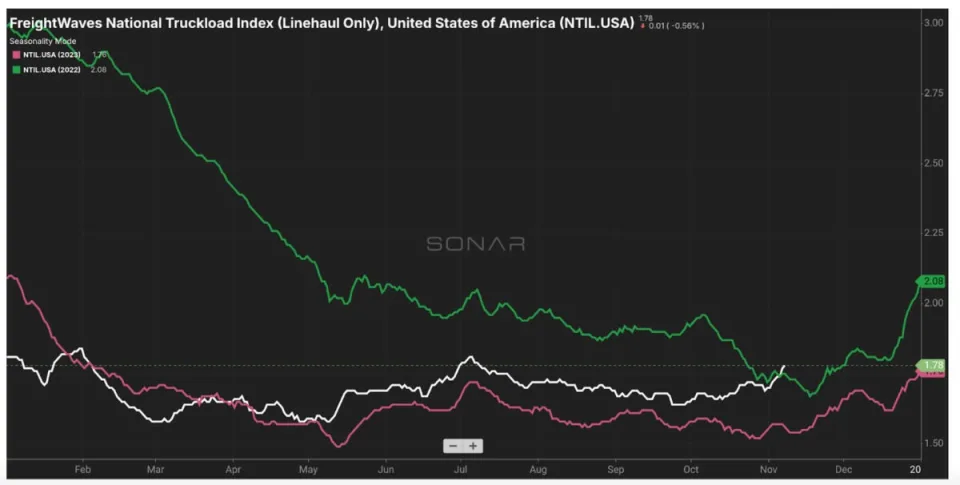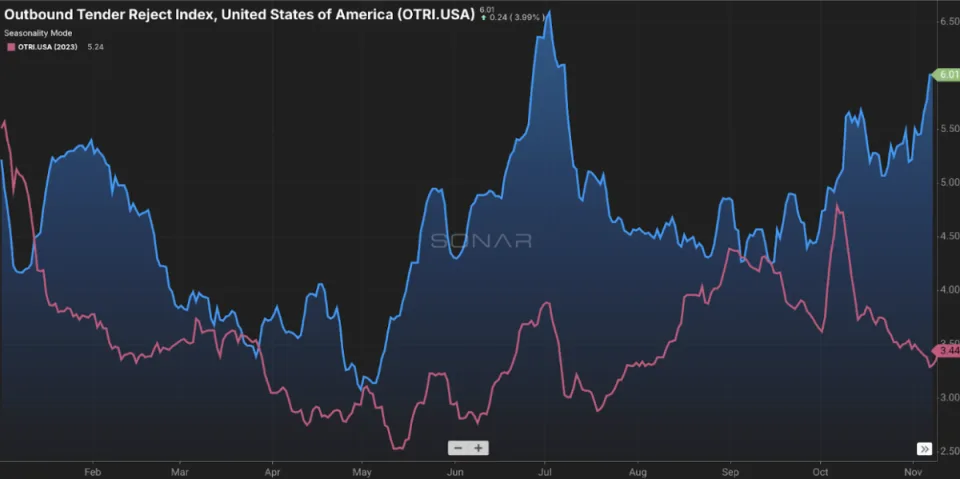Understanding the End of the “Great Freight Recession”: A Warrior Market Shift
The freight industry has been under stress, enduring a prolonged period of low rates and decreased demand that some have called the “Great Freight Recession.” However, the industry indicators now show that this downturn may be ending, with signs pointing toward a gradual recovery.
1. Indicators of Recovery: Rising Tender Rejections
The Outbound Tender Rejection Index (OTRI), a tool that tracks freight volume by monitoring the percentage of truckload rejections by carriers, provides strong signals of market improvement. Historically, a rise in tender rejections has indicated that carriers have more load options, enabling them to be more selective, while a decrease points to excess capacity and a surplus of carriers competing for fewer loads.
As of recent data, tender rejections have risen to above 6%, compared to a low of 3.4% the previous year. This increase suggests that capacity is tightening, potentially giving carriers a greater negotiating position. For context, tender rejections dropped significantly in the past year as capacity outpaced demand, so this uptick marks a critical pivot in market dynamics.


2. Spot Rate Increases Indicate Potential Demand Growth
Spot rates, which reflect the cost of shipping a load that’s posted last minute, have climbed beyond the levels seen in 2022 and 2023. This trend indicates that either demand is rising or available capacity is shrinking, or possibly both. The increase has been notable, with truckload rates moving from $1.54 per mile last year to $1.78 per mile today. This growth is surprising for many who expected low rates to persist, hinting at underlying changes in the demand for freight solution and services.
3. Potential for “Carrier Revenge”
The market’s recent shifts may also lead to what’s known as “carrier revenge,” where carriers regain bargaining power after an extended period of low rates and high competition. If carriers leverage this power, they may become more selective, which could affect logistics planning for shippers and disrupt standard routing guides. This trend could encourage shippers to re-evaluate their routing and contracting practices.
4. Upcoming Regulatory Changes Could Further Impact Capacity
The Federal Motor Carrier Safety Administration (FMCSA) is set to implement new Clearinghouse-II regulations, which will tighten requirements around commercial driving licenses (CDLs) starting on November 18, 2024. This rule could have a considerable impact on available capacity, as industry analysts estimate up to 177,000 truck drivers could lose their licenses if their records do not comply. This tightening of capacity could drive further increases in rates as fewer drivers remain available.
A Prolonged Recession’s Lasting Impacts
The recent freight downturn has lasted longer than the COVID-19-related boom that preceded it, showing how challenging this period has been for the logistic trucking industry. The extended recession, declared by FreightWaves in March 2022, initially faced skepticism. However, subsequent market data confirmed a prolonged dip in rates and demand, which has persisted well into 2024.
5. SONAR Insights: Tracking Market Balance and Demand Growth
FreightWaves’ SONAR platform, known for its high-frequency tracking of supply and demand metrics, provides valuable insights into the market’s health. SONAR data shows that OTRI values bottomed out around March 2024 but have since shown steady increases—a positive sign for the freight industry. Furthermore, contracted load volumes, another indicator of market demand, have risen 9% since January 2023. This increase highlights the market’s growth and suggests that the low points of the recession may be behind us.
Contract volumes, however, remain 6% lower than their peak in April 2021, indicating that there is still room for growth as the industry rebounds from its deepest downturn in decades.
6. Looking Forward: Recovery on the Horizon
Despite positive signals, industry experts caution that full recovery may still take time, with projections extending into 2025. However, the current data points to a turning point, with capacity starting to tighten and demand showing signs of steady increase. Analysts predict that as the economy strengthens, the freight market will gradually recover, bringing more balance to the supply and demand dynamic.
Key Takeaways
- Tender Rejections: Rising OTRI values signal improved carrier bargaining power and a possible end to the freight recession officially.
- Spot Rate Growth: Increased spot rates suggest a reduction in available capacity or a resurgence in demand.
- Regulatory Changes: Upcoming FMCSA rules could remove drivers from the market, further reducing capacity.
- SONAR Insights: High-frequency data tracking through SONAR has shown sustained demand growth, signaling market recovery.
This potential recovery is a positive signal for carriers who endured one of the freight industry recession is most challenging periods. By staying informed and adapting strategies to current trends, stakeholders can prepare for a changing market environment as freight demand begins to strengthen.
Final Thoughts
In a nutshell, the freight industry moves through the latter stages of this historic downturn, recent data signals optimism for carriers and shippers alike. The combination of increasing tender rejection rates, rising spot rates, and contracting capacity points to an eventual stabilization, bringing relief to those who have weathered this prolonged recession. The road to recovery may still be gradual, but the trucking industry is poised to see improved conditions over the coming years.




